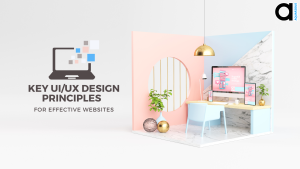Key UI/UX Design Principles for Effective Education Websites

In the contemporary digitalisation era, online education platforms play a pivotal and indispensable role in facilitating immersive and enriching learning encounters. Given the swift and relentless progress in technological advancements, it becomes imperative for educational institutions to craft websites that are both user-friendly and visually captivating, forging an optimal user experience. You can hire a website designing company in Kolkata to build a professional and effective website.
Introduction
As the world embraces online learning, educational institutions must adapt their websites to provide seamless user experiences. UI (User Interface) and UX (User Experience) design principles help achieve this goal. UI focuses on a website’s visual elements and aesthetics, while UX emphasises the overall experience and usability. By integrating these principles, education websites can create a positive and effective learning environment for students, teachers, and parents.
Understanding UI/UX Design
What is UI Design?
UI design refers to a website or application’s visual and interactive aspects. It comprises creating a visually appealing interface that is easy to navigate and understand. UI designers focus on elements such as colours, typography, icons, buttons, and layout to enhance the user’s visual experience.
What is UX Design?
Contrarily, user experience (UX) design directs attention towards the holistic encounter users undergo when interacting with a website or application. It encompasses the entire trajectory users embark on, from their initial arrival on the site to the culmination of their intended objectives. UX designers engage in meticulous user research, construct user personas, and fashion wireframes and prototypes, all in a concerted effort to refine and enhance the overall user experience.
Importance of UI/UX Design in Education Websites
The integration of UI/UX design holds immense significance in the realm of education websites, as it exerts a direct influence on user engagement, retention, and overall satisfaction. A meticulously crafted interface contributes to heightened usability, simplifying students’ navigation process as they traverse the course materials, access various resources, and engage in fruitful interactions with their peers and instructors. Moreover, a positive user experience bolsters the credibility of the educational institution, fostering a profound sense of trust in the minds of its visitors.
Key UI Design Principles
To create an effective education website, it is essential to consider the following UI design principles:
Consistency and Visual Hierarchy
Maintaining consistency across design elements, encompassing colours, fonts, and layout, facilitates a seamless navigation experience for users on the website. A unified visual hierarchy accentuates crucial information, directing users’ attention towards essential elements like course offerings, enrollment details, and valuable resources.
Intuitive Navigation
Intuitive navigation lets users find information quickly and easily. Clear and well-structured menus, search functionalities, and breadcrumb navigation aid users in exploring different sections of the website effortlessly.
Responsive Design
With the increasing use of mobile devices, education websites must be optimised for different screen sizes. Responsive design ensures the website adapts to various devices, providing an optimal viewing and interaction experience.
Colour and Typography
Carefully chosen colours and typography create a visually appealing and engaging website. Colours can evoke emotions and reinforce branding, while typography enhances the readability and comprehension of textual content.
Accessibility
Education websites should be accessible to users with disabilities. Implementing features like alt text for images, keyboard navigation, and video captioning ensures equal access to information for all users.
Key UX Design Principles
When designing education websites, the following UX design principles should be considered:
User Research and Persona Development
To create a user-centred website, it is essential to comprehend the demands and preferences of the target audience. To produce customised experiences, user research and persona development help uncover user goals, pain spots, and motivations.
Clear Information Architecture
A clear information architecture ensures that content is organised logically and intuitively. Well-structured menus, categorisation of courses, and intuitive labelling make it simple for users to find relevant information quickly.
Effective Content Presentation
Presenting educational content concisely and engagingly is vital. Incorporating multimedia elements, such as videos and interactive quizzes, enhances the learning experience and keeps users actively engaged.
Seamless Interaction and Feedback
Interactive elements like discussion boards and feedback forms facilitate communication and cooperation between students and instructors. Providing notifications and feedback on time keeps consumers informed and interested throughout their learning process.
Performance Optimisation
Optimising website performance, such as page load speed and responsiveness, is crucial for a smooth user experience. Slow-loading pages can frustrate users and lead to higher bounce rates.
Integration of UI and UX Design
Even though UI and UX design principles are separate, they are interrelated and should be incorporated smoothly. While UX design focuses on improving the overall user experience, UI design improves the aesthetics and visual appeal of the website. Education websites can provide consumers with a seamless and exciting experience by adhering to these standards. Hire a website designing company in Kolkata to help you with it.
Case Studies of Effective Education Websites
To illustrate the successful implementation of UI/UX design principles, let’s explore two case studies:
Khan Academy
The well-known and highly effective educational website Khan Academy provides many free online tools and courses. The website has grown popular due to its user-friendly design, excellent instructional materials, and customised learning environment.
Users may easily explore and access pertinent content on the Khan Academy website because of its clear and user-friendly design. It hosts a vast library of instructional videos, drills, and interactive tests on various topics, including maths, physics, the humanities, and more. Students can advance at their own pace because the material is well-structured into manageable sections.
The website incorporates an adaptive learning system that tracks users’ progress and suggests relevant content based on their performance and preferences. Khan Academy employs gamification elements such as badges, points, and progress tracking to motivate learners.
Coursera
Coursera is an online learning platform that partners with universities and organisations worldwide to offer various courses, certifications, and degrees. It has become a leading platform for online education.
The website offers thorough course descriptions, syllabi, and user reviews so that students can choose their learning route with knowledge. With the help of reputable colleges, Coursera offers degree-level programmes and certifications that have been granted official accreditation. Because of this cooperation, Coursera is a popular option for students seeking recognised credentials because it guarantees the quality and legitimacy of the courses offered. To establish an interactive learning environment, it uses various instructional forms, including video lectures, quizzes, assignments, and discussion forums. On Coursera, a lot of the courses emphasise real-world abilities and information that are pertinent to market demands.
Conclusion
Implementing UI/UX design principles is essential for creating effective education websites. By focusing on UI design principles such as consistency, intuitive navigation, and responsive design and incorporating UX design principles such as user research, clear information architecture, and seamless interaction, educational institutions can provide engaging and user-friendly platforms for learning. Embracing these principles not only enhances the user experience but also presents the success of educational initiatives.
If you are looking to hire professional web designers and developers for your brand but are on a budget, Aquarious Technology, a website designing company in Kolkata is here to help you. Reach out to learn more.
-
14
+Category
-
98
+Post
Top Categories
Popular Posts
- The Power of Prototyping in Software Development
- Version Control Best Practices for App Development
- Understanding Visual Hierarchy: A Guide to Effective Design
- Crafting Intuitive Navigation: A Guide to Seamless User Experience
- Choose Your Best Cloud Provider
- Making the Leap: Transitioning from Manual to Automated Software Testing
- Using GitHub- Advantages and Disadvantages
- E-commerce Product Photography on a Budget
- Tech Innovation in Developing Countries
- Smart Cities: How Technology is Shaping the Urban Landscape
- Principles of Composition: Creating Visual Harmony with Composition
- Exploring Cross-Platform App Development
- Why Regular Website Updates Matter
- Navigating Effective Facebook Audience Targeting
- Implementing Ads for Game Monetization
- Designing User-Centric Mental Health Apps: Enhancing Well-being in the Digital Age
- NFTs and Collectibles: Creating NFT App Solutions for Collectors and Enthusiasts
- Successful Implementation of Enterprise Apps
- Maximizing Business Impact with EQ
- Proven SMO Ads Optimization Tips (2023)






